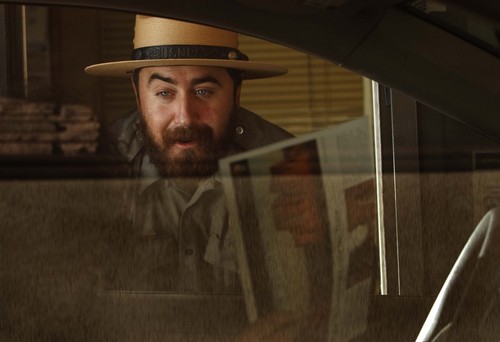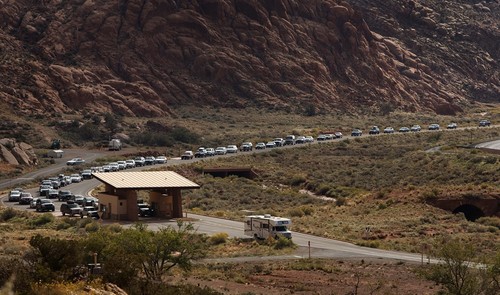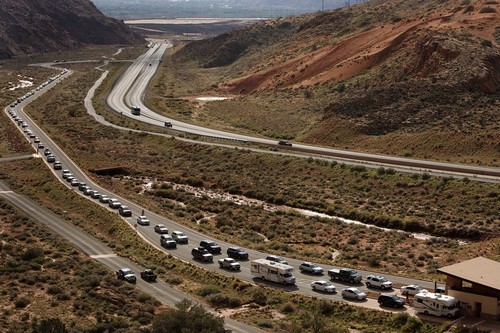This is an archived article that was published on sltrib.com in 2013, and information in the article may be outdated. It is provided only for personal research purposes and may not be reprinted.
Moab • As Americans and foreign tourists were welcomed back into Utah national parks this weekend, Moab businesses were celebrating the beginning of a 10-day reprieve — courtesy of Utah taxpayers — from the budget crisis freezing the rest of the federal government.
Main street business were humming Friday night as visitors flooded into town. But the lack of a permanent solution to the parks closure dampened the mood and some were wondering how much of the fall season could be salvaged.
"A lot of businesses lost 30 percent last week and were expecting bigger losses this week," said Arlo Tejada, marketing director of Sheri Griffith River Expeditions. "This is when they make money. This is the second busiest month [after May]. When you have a bus with 40 or 50 people cancel, that's a lot of rooms."
His company had no river trips planned this month, but Tejada estimated the government shutdown has cost it $10,000 in lost catering business from cancelled bus tours.
Saturday morning, tourists poured into a fully open Arches National Park, just a few miles north of town. Cars backed up from the entrance station to U.S. Highway 191.
The National Park Service could not make anyone available for comment Saturday and staff, fresh off an 11-day furlough, said they were not authorized to speak to the media.
Gov. Gary Herbert on Thursday had convinced the Department of Interior to accept $1.7 million in state money to operate the state's five national parks, along with Natural Bridges and Cedar Breaks national monument and Glen Canyon National Recreation Area, including Rainbow Bridge National Monument, through Oct. 20.
Utah hopes the feds repay the "donation" but there is hardly any guarantee. In a statement, Sen. Orrin Hatch, R-Utah, said he is " working to get Utah its money back for loaning the Department of Interior the money to reopen the parks. Governor Herbert did the right thing, and Utah deserves to be repaid."
This is not the first time the feds have used outside money to run, fix up and even establish national parks, according to University of Utah law professor Robert Keiter. He noted local communities have put up the money for snow plowing to get Yellowstone open earlier in the year, private money covered the renovation of the Statue of Liberty and Appalachian states acquired the land that became the Great Smoky Mountains National Park.
"This clearly highlights the vitally important role the national parks play in local economies in southern Utah and across the United States," said Keiter, who directs the U.'s Wallace Stegner Center for Land, Resources, and the Environment.
Indeed, Herbert sees the deal as a vital investment to shore up Utah's tourism-dependent rural communities, blessed with world-class scenery but short on industry.
At the entrance to Bryce Canyon National Park, the lobby at Ruby's Inn was empty yesterday afternoon — and Lance Syrett couldn't have been happier.
"Everybody was at the park," said Syrett, general manager of the inn, which he said received more than 400 new reservations over the past 24 hours as news spread that Utah's national parks were opening.
The response was "spectacular," Syrett said Saturday, "more than we expected to get."
Syrett had set up an information center in the hotel's lobby to help tourists figure out other options after the parks closed. He said there was "lots of confusion, a lot of anger" even as people tried to make the best of the situation.
On Friday, "there was definitely a different feeling among our guests, almost a festive-type feeling going on," he said.
Still, Ruby's Inn hosts mostly international visitors at this time of year, and getting word to them so they'll return is "going to take a little bit of time," Syrett said, whose family has operated an inn next to Bryce since 1923.
In Grand County, about two-thirds of the 2.5 million annual visitors see parks and tourism accounts for three-fourths of the local economy, according to the county's recent declaration of a local emergency. Closing Arches, which logs 90,000 visits in a typical October, robbed Moab of a powerful draw.
The 126-room Moab Valley Inn has seen 205 cancellations for the month of October since the parks closed, according to clerk Marsha Ferguson. Only one-third of the rooms are booked next Friday, the heart of Utah schools' fall break, when many families strike out for the desert.
"It's not just hotels and outfitters. Gas stations were losing $1,000 a day. Others lost $350 a day just on breakfasts," said Marian DeLay, executive director of the Moab Travel Council. Still, the parks re-opening is a "blessing" for many businesses that can count on at least a modest uptick in traffic, she said.
"All the people planning to come during [the Utah Education Association fall break] know they can come and enjoy the weekend in the park," DeLay said. "I don't know [if] we'll salvage it all. We've had quite a few businesses suffer greater losses that they should have."
She surveyed 28 Moab businesses last week and calculated they were each losing on average $720 every day of the shutdown. That amounts to losses of more than $300,000 a day for the county, according to DeLay.
The shutdown also burned countless travelers. Michael Huot, his three brothers and a dozen of their friends were shut out of their White Rim journey, an epic bike ride in Canyonlands National Park overlooking the Green and Colorado rivers.
"The government is there to represent the people. The land belongs to the people. It's frustrating the government is keeping the people out," Huot said Friday while enjoying what was left of his Utah vacation in Arches.
The lesson he is taking back home to South Dakota is to plan national park trips for September, rather than October when the government's fiscal year begins.
Italian Johannes Hopfgartner is on a three-month North American odyssey, but arrived on the Colorado Plateau this month to see the park gates slammed shut.
"I was totally disappointed. My whole trip was based on national parks," he said.
He made the best of his stay at other sites, such as Monument Valley. But on Friday he was reveling in the sunset glow at Delicate Arch, thinking about how to get to Bryce Canyon, Zion and Canyonlands national parks while they remain open.
"I've heard Utah stands up for people and tourists," a beaming Hopfgartner said.
But the parks are just a piece of the area's offerings, which include river running, camping, hunting, climbing and cycling in a diverse array of sandstone and mountain landscapes.
Tejada was among 75 Utah business operators who signed an Oct. 4 letter to the state's congressional delegation imploring Congress to pass a budget that gets federal land agencies — not just the parks — back on the job.
"These public land closures put at risk Utah's outdoor industry, which annually contributes $3.6 billion in wages and salaries and over $856 million in state and local tax revenue," states the letter, sent under the Utah Outdoor Business Network letterhead.
Moab has weathered the shutdown better than Springdale outside Zion National Park because it has so much non-park recreation nearby, according to Ashley Korenblat, a Moab-based cycling guide.
After the first week of the shutdown, lots of park-bound visitors went home happy because they still had great experiences at places such as Fisher Towers, Corona Arch and Negro Bill Canyon, she said.
Dead Horse Point State Park has seen record attendance during the shutdown, and campers piled into the county-operated Sand Flats Recreation Area. Still, because most non-park destinations are federally managed, many campgrounds, river put-ins and other developed recreation sites remain closed.
"Re-opening the parks is very much a temporary solution. People are camping in random spots," Korenblat said. "The land managers perform an important function that people need to be aware of, like protecting endangered species and deciding where to [allow] oil and gas [drilling]."
Despite the parks' reopening, Tejada still can't book next year's river trips through Labyrinth and Desolation canyons or Dinosaur National Monument. And no one knows whether Utah's parks will even be open past Oct. 20.
"Certainty is incredibly important. People want a vacation where they know what to expect. If they don't have a guarantee, they won't go," Tejada said.













